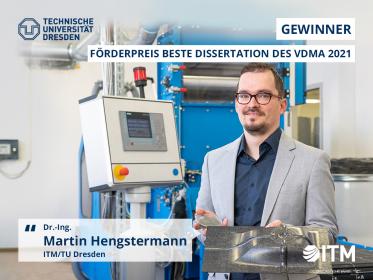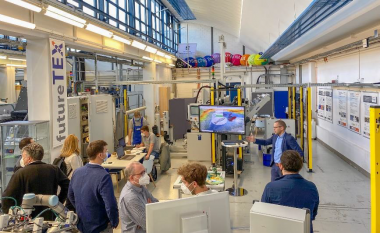Förderpreis beste Dissertation des Deutschen Textilmaschinenbaues 2021 an Dr.-Ing. Martin Hengstermann
Die Verleihung der Förder- und Kreativitätspreise 2021 der Walter Reiners-Stiftung des VDMA, Fachverband Textilmaschinen an Studierende und Nachwuchswissenschaftler:innen deutscher Universitäten für Spitzenleistungen in Studium und Promotion fand am 09. November 2021 im Rahmen der Aachen-Dresden-Denkendorf International Textile Conference 2021 statt. Die bundesweit ausgeschriebenen Förder- und Kreativitätspreise wurden erneut online durch Herrn Peter D. Dornier, Vorstandsvorsitzender der Walter Reiners-Stiftung, verliehen.
Dr.-Ing. Martin Hengstermann wurde mit dem mit 5.000 EUR dotierten Förderpreis beste Dissertation des Deutschen Textilmaschinenbaues 2021 für seine am Institut für Textilmaschinen und Textile Hochleistungswerkstofftechnik der TU Dresden erarbeiteten Dissertation „Entwicklung von Hybridgarnen aus recycelten Carbonfasern und Polyamid 6-Fasern für thermoplastische Verbundbauteile mit hohem Leistungsvermögen“ geehrt.
Gegenstand der Dissertation ist die Entwicklung und Umsetzung von neuartigen Hybridgarnen aus recycelten Carbonfasern (rCF) und Polyamid (PA) 6-Fasern für thermoplastische Verbundbauteile. Diese Hybridgarne können die hervorragenden mechanischen Eigenschaften der rCF im Gegensatz zu bisherigen Lösungen in hohem Maße ausnutzen. Bedingt durch deren spezielle Fasereigenschaften (insbesondere hohe Querkraftempfindlichkeit, Sprödigkeit und fehlende Kräuselung) wurde dafür die Prozesskette der konventionellen Stapelfasergarnherstellung, bestehend aus Krempel, Strecke und Flyer, umfangreich analysiert und technologisch-konstruktiv weiterentwickelt, wodurch erstmalig eine schonende und gleichmäßige Herstellung der Hybridgarne ermöglicht werden konnte.
Technische Universität Dresden
Institut für Textilmaschinen und Textile Hochleistungswerkstofftechnik (ITM)


















